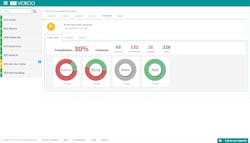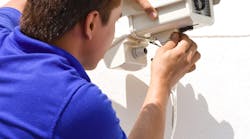The core of a networked security solution is the camera, which provides the video that drives security operations in businesses of every size; however, these devices can, in today’s digital age, often become an appealing target for hackers as a point-of-entry to businesses’ network. In fact, cybersecurity firm Trend Micro found in 2017 that more than half of surveillance cameras they tracked in North America had been infected with malware, which was mostly undetected by end-users.
To combat hacking and other vulnerabilities, camera manufacturers have more frequently updated firmware to keep ahead of cyber criminals, in addition to releasing new features. Managing frequent updates for surveillance cameras in a network can be a large undertaking, especially if each update must be managed individually. Each time a firmware update is released for an entire network of cameras, it can create an arduous and time-consuming task for maintenance or security personnel.
These frequent updates have created the need for a camera firmware update management software to help automate the process. With a single program to perform all firmware updates across a security system, it is much easier for organizations to better secure physical property, people and assets while mitigating risk. There are a multitude of benefits to the implementation of a camera firmware update manager on a security system.
Manual methods of camera firmware updating do not scale; in fact, changing the firmware for individual cameras often requires someone to locate every camera, climb a ladder and insert a USB flash drive that contains the firmware update to install it.
Camera device manufacturers, seeing the need for reliable firmware updates, are beginning to offer automated capabilities for updating firmware on their cameras; however, the software does not address security systems with multiple manufacturers, models and types of camera devices. Furthermore, vendor-specific solutions are only designed to work on a site-by-site basis.
Additionally, security departments need not only to trust the operator doing the update, but the firmware itself. It is essential to ensure the update comes from a trustworthy source, and to be able to obtain a chain of custody of that firmware as it progresses within the network. The tampering with firmware before or as it moves through a security system is an easy delivery mechanism for cyber criminals. A camera firmware update manager creates this chain of custody and ensures firmware comes from, and goes through, only trusted sources.
RMR Creation
Camera firmware update managers can be a key addition to the managed services offering of an integrator, and thus increasing their RMR. The primary change integrators need to embrace is the transition in the industry from providing largely reactive maintenance, and move towards taking a more proactive approach.
With today’s integrated security systems, a single device failure could take down a meaningful portion of the security infrastructure. Until the device can be repaired, replaced or simply restarted, security will be compromised. This means that firmware updates being reliably performed across the entirety of a system, with a chain of custody ensuring that only trusted sources provide these updates, is now a critical part of security system maintenance, and can be an important value-add for integrators and resellers looking to move their portfolios to a more proactive maintenance focus.
Resellers can therefore enhance their service offerings by adding automated camera updates to their portfolios as an easy new source of RMR that requires little to no learning curve for them to implement.
Integrators who move out of their comfort zones and embrace the changing landscape that new technologies provide, such as by providing a camera firmware update manager, can offer the services that end users want.
Offering a service program that eliminates downtime, automatically ensures that video is recording properly, fixes are performed quickly, and provides objective verification of physical security system performance is an important value-add that is likely to get a customer’s attention. By focusing on proactive solutions that can help ensure that their customer’s systems operate reliably, integrators have the opportunity to become a trusted partner, rather than simply another vendor trying to make a sale.
Bud Broomhead is CEO of Viakoo. Request more info about the company: www.securityinfowatch.com/11706569.





